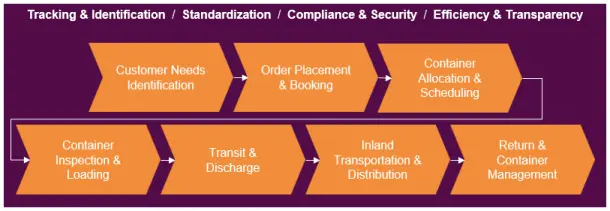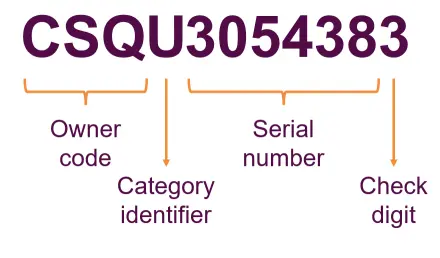In the fast-paced landscape of global trade, the Port of Rotterdam stands as a beacon of efficiency and innovation. As Europe’s largest seaport (handling close to 9 million containers annually1), it serves as a vital gateway for the movement of goods between continents. Behind its towering cranes and bustling terminals lies a meticulously designed framework known as Enterprise Architecture (EA). It plays a pivotal role in orchestrating the complexities of container shipments. At the heart of the Port of Rotterdam’s EA strategy is the use of container codes. This embodies a standardized system that facilitates seamless communication and coordination on a global scale. In this blog, we will explore how Rotterdam Port uses a globally scaled Enterprise Architecture. We’ll dive into container codes and how they are used to optimize container shipments while ensuring smooth operations in the global trade ecosystem.
Enterprise Architecture at the Port of Rotterdam
The Enterprise Architecture serves as a blueprint for the organizational structure and operations of the Port of Rotterdam. Evidently, it aligns business drivers and objectives with organizational and technological capabilities. As a result, it enables the port to achieve its goals efficiently and effectively. Within this framework, the Port of Rotterdam’s EA comprises various components, including processes, data, applications and infrastructure. By integrating these elements cohesively, the port can streamline its operations, improve decision-making and adapt to changing market dynamics. In effect, this is where the value of EA really shines.
Creating Customer Value
Enterprise Architecture can be used to visualize the value that the Port of Rotterdam delivers to its customers. In other words, applying EA to the shipping container management process at the Port of Rotterdam involves mapping out the value stream – the sequence of activities that create value for customers and stakeholders.

Container Codes
Central to the Port of Rotterdam’s EA strategy is the use of container codes, also known as ISO 6346 codes or BIC (Bureau International des Containers et du Transport Intermodal) codes. These unique identifiers, typically consisting of four letters followed by seven digits, are assigned to individual shipping containers. Container codes serve several purposes in global trade, including:

- Tracking and Identification. Container codes enable precise tracking and identification of shipments throughout their journey. From the moment a container leaves its origin until it arrives at its destination, stakeholders can monitor its status in real time, facilitating efficient logistics management.
- Standardization. By adhering to a standardized coding system, the Port of Rotterdam ensures consistency and interoperability across its operations. Regardless of origin or destination, all containers passing through the port are marked with container codes, streamlining communication and reducing errors.
- Compliance and Security. Container codes play a critical role in ensuring compliance with international regulations and security standards. By providing detailed information about container contents, origin and destination, these codes enable customs authorities to assess security risks and effectively enforce regulatory requirements.
- Efficiency and Transparency. The use of container codes increases efficiency and transparency in container handling and logistics. By providing stakeholders with real-time visibility into container movements, the Port of Rotterdam fosters trust and collaboration across the supply chain, ultimately leading to greater operational efficiency.
In architectural terms, the purposes mentioned here are the drivers for the Port of Rotterdam. They can be easily linked to the value stream stages as shown in the figure above. The words in italics in the bulleted list above can readily be translated into capabilities.
Global Scale Utilization
One of the most compelling aspects of container codes is their universal applicability. This is another corresponding feature compared to EA. Regardless of geographic location or jurisdiction, the same coding system applies, allowing for seamless communication and coordination on a global scale. The Port of Rotterdam’s use of container codes extends beyond its own operations to a vast network of partners, including shipping lines, freight forwarders, customs authorities and terminal operators.
At any given moment, thousands of containers bearing the Port of Rotterdam’s container codes are crossing the world’s oceans. These codes are connecting continents and facilitating international trade. Whether a container is destined for Asia, Africa, the Americas or elsewhere, its journey is governed by the same standardized coding system. This ensures consistency and compatibility across borders. The global adoption of container codes underscores their importance as a fundamental element of modern maritime logistics. It enables the efficient movement of goods by leveraging a globally scaled architecture.
Practical Application of Capabilities
In practice, the Port of Rotterdam’s use of container codes is manifested in various ways in its operations:
- Terminal Operations. At Rotterdam’s container terminals, automated systems scan container codes upon arrival, ensuring accurate tracking and efficient handling. By automating key processes, the port minimizes turnaround times and maximizes throughput, increasing overall productivity.
- Customs Clearance. Container codes play a critical role in customs clearance procedures, because they allow authorities to verify the contents and origin of incoming shipments. For instance, by providing detailed information on container contents and related documentation, the Port of Rotterdam facilitates smooth customs processing. It also reduces delays and expediting cargo flows.
- Logistics Management. The Port of Rotterdam uses container codes to optimize logistics management, from container storage and handling to inland transportation. I.e., by integrating container code data with advanced analytics and forecasting tools, the port can anticipate demand, optimize resource allocation, and minimize supply chain disruptions.
- Supply Chain Visibility. Through integrated data-sharing platforms, the Port of Rotterdam provides stakeholders with real-time visibility into container movements. To illustrate, by sharing container code data with shipping lines, freight forwarders, and cargo owners, the port fosters collaboration and transparency across the supply chain. It also enables proactive decision making and risk management.
Towards a Smart Port Ecosystem
As the Port of Rotterdam looks to the future, the evolution of Enterprise Architecture will be inextricably linked to the concept of smart ports. By leveraging transparant business operations, emerging technologies and innovative solutions, the port aims to create a seamlessly connected ecosystem where physical infrastructure, digital platforms and intelligent algorithms converge to optimize operations and deliver value to stakeholders. From automated container terminals to blockchain-based supply chain platforms, the possibilities for innovation are endless. By embracing the principles of Enterprise Architecture and harnessing the power of container codes, the Port of Rotterdam is poised to remain at the forefront of global trade for years to come.
Conclusion
In summary, the Port of Rotterdam’s use of Enterprise Architecture and container codes exemplifies its commitment to excellence and innovation in maritime logistics. Through the use of standardized coding systems – derived from sound Enterprise Architecture implementation and execution – the port is creating business (and stakeholder) value. It does so by streamlining operations, improving visibility and fostering collaboration across the global supply chain. The Port of Rotterdam continues to pave the way for a more connected and efficient future for maritime trade. This has all been made possible by the strategic application of Enterprise Architecture.
As an illustration, if you look through your eyelashes, you will see the role that Enterprise Architecture has played and is playing at the Port of Rotterdam. For efficient operations, Enterprise Architecture is used (think of the use of value streams, for example). Also, capabilities were used to determine the most optimal transport method. Last but not least, the container codes are based on Enterprise Architecture principles; global (generic) agreements.
Noteworthy detail: even the header of this blog hints at the underlying Enterprise Architecture. For example, the header shows a container (left half) that morphs into a ship of containers. Thus, if you focus on the outline of the image, you can see the value stream element.







Leave a Reply